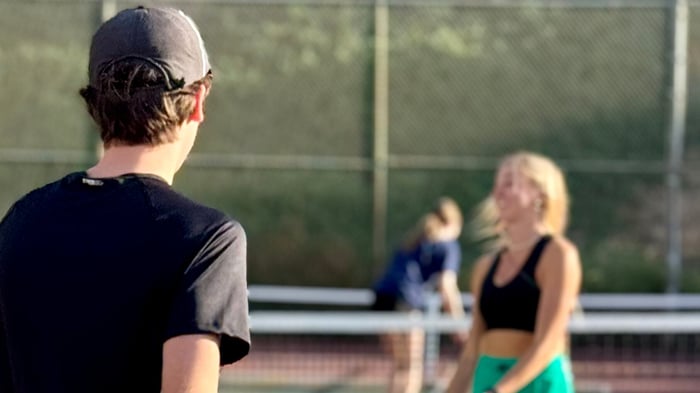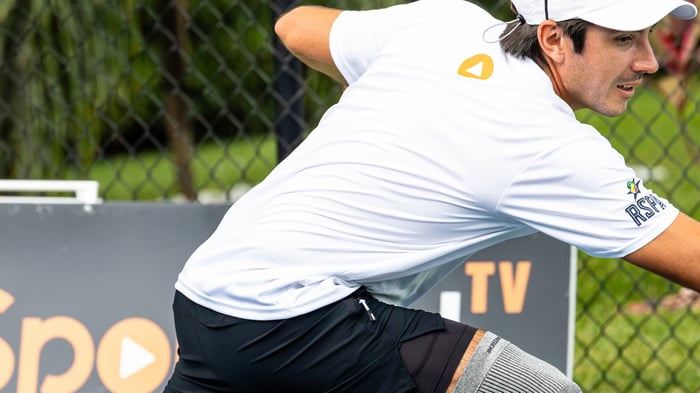Key takeaways:
Focused pickleball drills targeting specific skills like footwork, dinking, and third shot drops can accelerate improvement and build competitive confidence faster than casual play.
Consistency, repetition, and progressive mastery are the cornerstones of effective drills, helping players develop muscle memory and execute under pressure.
The right performance-ready gear, including supportive footwear and moisture-wicking apparel, enhances practice sessions by improving comfort, focus, and movement efficiency.
What really sets top-tier players apart from those stuck in a plateau? It all comes down to intentional, strategic practice. The most successful pickleball competitors don’t just spend time on the court; they make every minute count. They focus on drills that build technical precision, reinforce muscle memory, and boost their on-court confidence.
While it’s easy to fall into the habit of playing casually and hoping for improvement, real progress comes from targeted drills that push your skills forward. Drills like the well-known 7-11 are popular among competitive players because they train rhythm, consistency, and control. Meanwhile, focused serving exercises help you take control of points from the very first hit. The key is choosing the right drills to match your current level and specific goals.
In this guide, we’ve pulled together ten proven drills that cover all the essentials, from footwork and shot accuracy to doubles coordination and game-day focus. Each one is adaptable for a range of skill levels, whether you’re gearing up for your first tournament or chasing that next big league win.
What makes a pickleball drill effective?
The most effective pickleball drills all have a few things in common. They target specific skills, include consistent repetition, and build confidence through gradual progress. Unlike casual play, where shots happen in random patterns and it’s easy to fall into reactive habits, structured drills give you the chance to isolate one technique at a time and really focus.
Repetition is key, no matter your skill level. When you repeat the same motion over and over in a controlled setting, your brain and body start to work together more efficiently. That movement becomes automatic. Competitive players rely on this muscle memory when the pressure’s on, and it’s what allows you to execute tough shots with confidence during real matches.
The beauty of drills is that you can scale them. Start simple, then add challenges over time; more speed, tighter targets, or game-like scenarios. This approach doesn’t just improve technique. It builds real confidence, because you know you’ve put in the reps and your body is ready to respond when it counts.
#1. Mastering footwork with ladder drills
Every great pickleball shot starts with solid footwork. Players who move efficiently and with control have a huge advantage; they can chase down tough shots, stay balanced during fast-paced rallies, and position themselves for offensive plays that slower players often miss. When your movement becomes second nature, you free up mental space to focus on strategy and shot selection instead of just trying to get to the ball in time.
Ladder drills are one of the best ways to build this type of agility. Start simple with lateral shuffles, stepping sideways through each square of the ladder while keeping your knees bent and weight on the balls of your feet. Then try the “in-in-out-out” pattern, stepping both feet inside a square, then both feet out before moving to the next. These drills improve lower-body strength, joint stability, and directional control; all essential for explosive, injury-free movement on the court.
Wearing the right shoes makes these drills even more effective. Footwear, like the PB5 Court2 shoes with proper lateral support, helps you move with precision and confidence, reducing the risk of slipping or twisting your ankle mid-drill.
#2. Dinking technique for controlled rallies
The dink shot is where finesse beats force. It’s the quiet chess match of pickleball, where soft hands and smart placement can win you the point without ever needing a powerful hit. A well-placed dink keeps your opponent off balance and sets you up to take control of the rally.
Start with the Figure 8 Drill. Stand at the kitchen line with a partner, and alternate dinks crosscourt and down the line in a figure-eight pattern. It’s great for refining touch, accuracy, and consistency. Once that feels natural, try the 2-Touch Dink Ball Control Drill. It helps you develop restraint and feel, so you avoid popping the ball too high or hitting it too hard, two common mistakes that break down rallies.
Want to take it up a notch? The Battleships Drill adds speed and strategic variation. You'll learn when to play it safe and when to push your advantage. Add a point system to simulate match pressure and make each rally count. These drills are easy to scale based on skill level, which makes them great for both newer players and experienced ones looking to fine-tune their net game.
#3. Perfecting the third shot drop
The third shot drop is one of the most important shots in pickleball; it’s your bridge from defense to offense. This soft, controlled shot helps you take control of the rally by giving you time to approach the net, where you can apply pressure and dictate play. When executed well, it forces your opponents to hit up on the ball, giving you the advantage.
Try the “0 to 60” Drill to dial in your consistency. One player starts at the baseline while the other feeds balls from the kitchen line. The goal is to hit 60 clean, successful drops, no errors. This drill not only builds consistency but also helps simulate game-like pressure while developing touch and control from the back of the court.
The beauty of this shot is that anyone can learn it with focused practice. Beginners might start by practicing the motion without a net, just working on the feel of the shot. More advanced players can add movement, vary their targets, and simulate real match scenarios. Over time, the third shot drop becomes a dependable tool that helps you stay in control when the point begins.
#4. Volley control exercises for quick reactions
Strong volley control can turn a reactive player into an aggressive net presence. When you’re comfortable handling fast-paced shots at the kitchen line, you can hold your ground and take control of rallies. Drills like the Tennis Ball Drop and Rebounder Transitions are great for sharpening reflexes and paddle control, helping you handle anything your opponent throws your way.
Add speed and pressure with rapid-fire drills like Speed Variation Volleys or Multi-Ball Feed, where a partner sends 20 to 30 balls your way in quick succession. Focus on blocking and countering, maintaining a ready stance with your paddle up. Performance apparel that moves with you is key during these drills, so you can stay light on your feet without any restrictions.
#5. Serve consistency practice for reliable starts
Your serve is the one shot where you’re fully in control, so it’s worth investing the time to make it consistent and effective. Target drills help improve placement, while depth variation exercises develop the unpredictability that keeps opponents guessing.
Add pressure with progression-based drills like the Three, Five system or time-limited serve challenges. The goal is to build muscle memory through repetition while maintaining solid form. Gear also plays a role here; moisture-wicking, flexible clothing helps you stay focused and comfortable through longer practice sessions.
#6. Return of serve drills for aggressive positioning
The return of serve often sets the tone for the entire point. Hitting deep, well-placed returns can immediately push your opponents back and make their third shot more difficult. Drills like the Depth Return and Placement Pattern are great for building consistency and forcing your opponents out of position.
Once you're comfortable with depth and direction, progress to the Attacking Placement Drill, targeting weaker sides or adding pace. Whether you’re playing singles or doubles, mastering this shot gives you an early edge. Solid footwear with lateral support is essential here, especially as you move forward to take the net after each return.
#7. Net play positioning for tactical advantage
Being at the net is all about positioning and anticipation. It’s not just about standing at the kitchen line but knowing where to be and how to move. The Split-Step Anticipation Drill helps you stay light on your feet and react quickly by timing your movement with your opponent’s shot.
To build synergy in doubles, try the Partner Mirror and Switching Responsibilities drills. These exercises improve communication and coordinated movement, helping you and your partner cover the court efficiently. The more you practice these patterns, the more confident and connected you’ll feel during real match play.
#8. Transition zone movement for seamless play
The transition zone can make or break your ability to reach the net safely. Drills like Traffic Light Decision help you recognize when to move forward or stay back based on your opponent’s paddle position, giving you smarter, more strategic movement.
As you improve, add the Step-and-Reset or Progressive Advance drills to simulate real gameplay pressure. These exercises help you stay balanced and in control during tricky in-between moments, turning a vulnerable area into an opportunity for offense.
#9. Forehand and backhand accuracy drills
Accurate groundstrokes are key to maintaining control and creating openings. Use the Three, Five, Seven drill to build consistency from the baseline through to the kitchen, and Target Zone drills to practice hitting precise locations.
Add variety with Direction Change and Movement-Based Accuracy drills, simulating real match conditions while reinforcing good form. Whether you’re hitting crosscourt or straight down the line, sharp shot placement keeps your opponents on the run and you in control.
#10. Partner communication drills for doubles synergy
Doubles success relies on clear communication. The Call and Switch Drill builds vocal habits like calling “mine” or “switch” during live play, while the Hand Signal Integration drill helps you communicate non-verbally for more tactical control.
Take it further with the Zone Responsibility and Pressure Challenge drills to improve court coverage and coordination under pressure. Regular feedback between partners reinforces trust and teamwork, two things every winning duo needs to thrive in competitive settings.
Frequently asked questions about pickleball drill techniques
These common pickleball training FAQs address the practical concerns that competitive players face when implementing structured drill practice. Understanding the optimal approach to frequency, tracking, and safety helps you maximize your training investment while building the skills that translate to match success.
How often should competitive players practice these drills for the best results?
Competitive players see the fastest improvement with 3-4 focused drill sessions per week, dedicating 45-60 minutes to targeted technique work separate from match play. Regular practice of serving and returning drills can increase your accuracy by up to 40% over a few weeks, according to performance studies of pickleball players. This frequency allows your nervous system to build muscle memory while providing adequate recovery time between intensive training sessions.
What's the best way to track progress and improvement?
Document your drill performance using specific metrics like successful shots out of total attempts, target accuracy percentages, or rally length achievements during each practice session. Video recording your technique during key drills provides visual feedback that helps identify areas for refinement and confirms positive changes in your form.
How can players avoid injury while increasing practice intensity?
Start each drill session with a proper 10-minute dynamic warm-up focusing on the specific movements you'll be practicing. Then, gradually increase intensity rather than jumping into high-speed repetitions. Quality footwear with proper lateral support becomes crucial during intensive drill work, allowing you to push harder while maintaining stability and reducing injury risk. Listen to your body and incorporate rest days between intense training periods, as muscle memory development happens during recovery periods between drill work.
Level up your technique and join the PB5star community
These ten drills aren’t just exercises. They’re a blueprint for building the confidence and skills that separate competitive players from casual ones. With focused, intentional practice, you’ll develop the precision and consistency needed to take control of matches. And when you pair that commitment with high-performance gear that moves with you and keeps you comfortable, you set yourself up for real, lasting improvement.
If you’re ready to push your limits, we’ve got everything you need. Dive into our skill-focused drills to fine-tune your training, and explore our premium gear designed for players who never settle for average. Join the PB5star community where growth, performance, and personal style come together. When you look good, feel great, and train smart, you're not just playing. You're leveling up.







